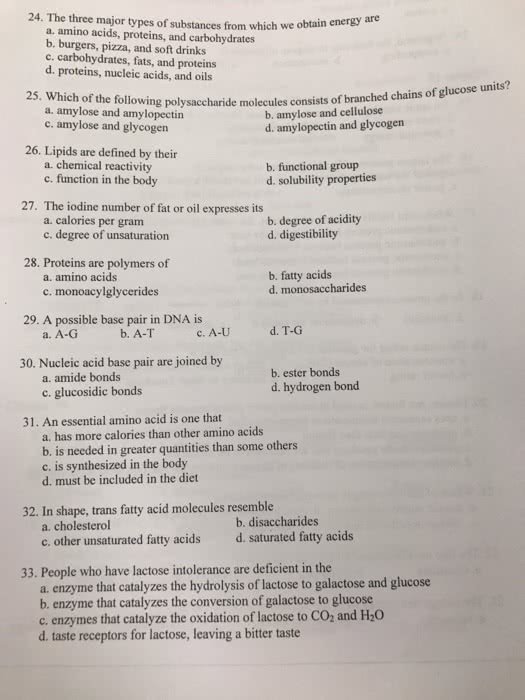NUTR100 Lecture Notes - Lecture 4: Short-Chain Fatty Acid, Guar Gum, Brush Border

Chapter 4: Carbohydrates
- Named by composition and impact on blood sugar levels
o Classified as simple sugars, includes starch and fibre
- Monosaccharides and Polysaccharides can provide energy to body
- Most important monosaccaride: Glucose, Galactose, Fructose
- Disaccharides: two simple sugar units: maltose, sucrose and Lactose
- Maltose is made whenever sugar is broken down
- Lactose is glucose linked to galactose, only natural animal sugar
- Hydrolysis: breaks sugar apart: use water to add hydroxyl to one and Hydrogen to the
other
- Condensation: links two sugar molecules together: takes a hydroxyl from one and
hydrogen from the other
- Mono and Disaccharides can be found naturally in plants
- Cople Cars: log hais of gluose oleules: ’s to thousads oleuels long
(polysaccharides)
- Starch is the storage form of glucose in plants, Glycogen is storage form of Glucose in
animals
- Starch
o Amylose and amylopectin(branched chains of glucose)
o Grains, legumes, tuber,
o Some plant starches not digestible, may benefit the colon
- Glycogen
o Animals store carbs as glycogen
▪ Stored in the liver and muscles
▪ Acts as a quick source of energy
o Not found in food
- Fibre
o Dietary: non digestible part of intact plants
▪ Grains, rice, seeds, legumes, fruits
o Functional Fibre: non digestible carbohydrate extracted from plants and added
to food
▪ Cellulose, guar gum, pectin, psyllium
o Total Fiber = dietary +functional
o Some fibre can be digested to short chain fatty acids (butyrate) in large intestine
o Bacteria in large intestine are collectively known as the microbiome
o Changes in the microbiome have been linked to important health effects
including obesity, gut health, and more
o Most fibre is undigested and secreted in feces
- Starch broken into shorter polysaccharides in mouth, in the stomach no carb digestion
- Small intestine most starch diegestion, breakdown of disaccharides. Pacreatic amylases
breakdown starch into mono, di, and oligosaccharide
- Enzymes attached to the brush border of the small intestinal vili complete the digestion
of carbs
find more resources at oneclass.com
find more resources at oneclass.com
Document Summary
Named by composition and impact on blood sugar levels: classified as simple sugars, includes starch and fibre. Monosaccharides and polysaccharides can provide energy to body. Disaccharides: two simple sugar units: maltose, sucrose and lactose. Maltose is made whenever sugar is broken down. Hydrolysis: breaks sugar apart: use water to add hydroxyl to one and hydrogen to the. Lactose is glucose linked to galactose, only natural animal sugar other. Condensation: links two sugar molecules together: takes a hydroxyl from one and hydrogen from the other. Mono and disaccharides can be found naturally in plants. Co(cid:373)ple(cid:454) car(cid:271)s: lo(cid:374)g (cid:272)hai(cid:374)s of glu(cid:272)ose (cid:373)ole(cid:272)ules: (cid:1005)(cid:1004)"s to thousa(cid:374)ds (cid:373)ole(cid:272)uels long (polysaccharides) Starch is the storage form of glucose in plants, glycogen is storage form of glucose in animals. Starch: amylose and amylopectin(branched chains of glucose, grains, legumes, tuber, some plant starches not digestible, may benefit the colon.


